A Public Health Review into Two Decades of Domestic Trampoline Injuries in Children within Queensland, Australia
Abstract
1. Introduction
2. Methods
- Fall mechanisms:
- Fall from: a fall from the trampoline onto surrounding ground including child being propelled from the trampoline (from jump height) or from the trampoline height.
- Fall through: a fall from the trampoline through the safety net, edge or the padding.
- Fall on: a fall on trampoline (i.e., on the edge of the trampoline or on the padding) without being propelled off of the trampoline.
- Non-fall mechanisms:
- Collision: when an injured person has collided with part of the trampoline, a person or an object nearby while playing on the trampoline.
- Entrapment/entanglement: when an injured person becomes entrapped in part of the trampoline (e.g., spring, net).
- Over exertion: mechanical hyper extension causing strain or sprain, including a twisted ankle and hyper extension and hyper flexion of the neck.
- Fall not elsewhere classified (NES): an unspecified falling mechanism.
3. Results
3.1. Demographic Distribution
3.2. Mechanism of Injury
3.3. Nature of Injury
3.4. Body Region
3.5. Injury Severity
3.6. Patterns of Injury Epidemiology and Mechanism
4. Discussion
5. Conclusions
Author Contributions
Funding
Institutional Review Board Statement
Informed Consent Statement
Data Availability Statement
Acknowledgments
Conflicts of Interest
Abbreviations
| ACCC | Australian Competition and Consumer Commission; |
| ATS | Australasian Triage Scale; |
| ED | emergency department; |
| NES | not elsewhere specified; |
| QISU | Queensland Injury Surveillance Unit; |
| UTS | University of Technology Sydney. |
References
- Hahn, J.; Shin, S.; Lee, W. The effect of modified trampoline training on balance, gait, and falls efficacy of stroke patients. J. Phys. Ther. Sci. 2015, 27, 3351–3354. [Google Scholar] [CrossRef] [PubMed]
- Giagazoglou, P.; Kokaridas, D.; Sidiropoulou, M.; Patsiaouras, A.; Karra, C.; Neofotistou, K. Effects of a trampoline exercise intervention on motor performance and balance ability of children with intellectual disabilities. Res. Dev. Disabil. 2013, 34, 2701–2707. [Google Scholar] [CrossRef] [PubMed]
- Alexander, K.; Clement, T.; Draper, N. Developing a mathematical model to predict energy expenditure while bouncing on a trampoline. Eur. J. Sport Sci. 2021, 21, 141–148. [Google Scholar] [CrossRef] [PubMed]
- Draper, N.; Clement, T.; Alexander, K. Physiological demands of trampolining at different intensities. Res. Q. Exerc. Sport 2020, 91, 136–141. [Google Scholar] [CrossRef] [PubMed]
- Hossain, I.; Zhou, S.; Ishac, K.; Lind, E.; Sharwood, L.; Eager, D. A measurement of ‘walking-the-wall’ dynamics: An observational study using accelerometry and sensors to quantify risk associated with vertical wall impact attenuation in trampoline parks. Sensors 2021, 21, 7337. [Google Scholar] [CrossRef]
- Kasmire, K.E.; Rogers, S.C.; Sturm, J.J. Trampoline park and home trampoline injuries. Pediatrics 2016, 138, e20161236. [Google Scholar] [CrossRef]
- Chen, M.; Cundy, P.; Antoniou, G.; Williams, N. Children Bouncing to the emergency department: Changes in trampoline injury patterns. J. Paediatr. Child Health 2019, 55, 175–180. [Google Scholar] [CrossRef]
- Eberl, R.; Schalamon, J.; Singer, G.; Huber, S.S.; Spitzer, P.; Höllwarth, M.E. Trampoline-related injuries in childhood. Eur. J. Pediatr. 2009, 168, 1171–1174. [Google Scholar] [CrossRef]
- Nauta, J.; Martin-Diener, E.; Martin, B.W.; Van Mechelen, W.; Verhagen, E. Injury risk during different physical activity behaviours in children: A systematic review with bias assessment. Sport. Med. 2015, 45, 327–336. [Google Scholar] [CrossRef]
- Eager, D.; Zhou, S.; Ishac, K.; Hossain, I.; Richards, A.; Sharwood, L.N. Investigation into the Trampoline Dynamic Characteristics and Analysis of Double Bounce Vibrations. Sensors 2022, 22, 2916. [Google Scholar] [CrossRef]
- Pendrill, A.M.; Eager, D. Free fall and harmonic oscillations: Analyzing trampoline jumps. Phys. Educ. 2014, 50, 64. [Google Scholar] [CrossRef]
- Kim, K.H.; Kim, H.S.; Kang, M.S.; Park, S.S. Varus shearing force is a main injury mechanism of pediatric trampoline-related injury in addition to compressive axial loading. PLoS ONE 2019, 14, e0217863. [Google Scholar] [CrossRef]
- Choi, E.S.; Jang, J.H.; Woo, J.H.; Choi, J.U.; Cho, J.S.; Yang, H.J. Pediatric trampoline-related injuries in a nationwide registry in South Korea, 2011 to 2016. Yonsei Med. J. 2018, 59, 989–994. [Google Scholar] [CrossRef]
- Roffe, L.; Pearson, S.; Sharr, J.; Ardagh, M. The effect of trampoline parks on presentations to the Christchurch Emergency Department. N. Z. Med. J. 2018, 131, 43–53. [Google Scholar]
- Fitzgerald, R.E.; Freiman, S.M.; Kulwin, R.; Loder, R. Demographic changes in US trampoline-related injuries from 1998 to 2017: Cause for alarm. Inj. Prev. 2021, 27, 55–60. [Google Scholar] [CrossRef]
- Stanbouly, D.; Stanbouly, R.; Baron, M.; Lee, K.C.; Selvi, F.; Chung Wen, R.W.; Chuang, S.K. A Review of 13,470 Head and Neck Injuries from Trampoline Jumping. Craniomaxillofacial Trauma Reconstr. 2022. [Google Scholar] [CrossRef]
- Korhonen, L.; Salokorpi, N.; Suo-Palosaari, M.; Pesälä, J.; Serlo, W.; Sinikumpu, J.J. Severe trampoline injuries: Incidence and risk factors in children and adolescents. Eur. J. Pediatr. Surg. 2018, 28, 529–533. [Google Scholar]
- Committee on Injury and Poison Prevention and Committee on Sports Medicine and Fitness. Trampolines at home, school, and recreational centers. Pediatrics 1999, 103, 1053–1056. [Google Scholar] [CrossRef]
- AS 4989:2003; Trampolines. Australian Standards: Sydney, Australia, 10 November 2003.
- Ashby, K.; Pointer, S.; Eager, D.; Day, L. Australian trampoline-related injury patterns and trends. Aust. N. Z. J. Public Health 2015, 39, 491–494. [Google Scholar] [CrossRef]
- Ashby, K.; Eager, D.; D’Elia, A.; Day, L. Influence of voluntary standards and design modifications on trampoline injury in Victoria. Inj. Prev. 2015, 21, 314–319. [Google Scholar] [CrossRef]
- AS 4989:2006; Trampolines—Safety Aspects. Australian Standards: Sydney, Australia, 3 October 2006.
- Eager, D.; Scarrott, C.; Nixon, J.; Alexander, K. Survey of injury sources for a trampoline with equipment hazards designed out. J. Paediatr. Child Health 2012, 48, 577–581. [Google Scholar] [CrossRef] [PubMed]
- Eager, D.; Scarrott, C.; Nixon, J.; Alexander, K. Injury survey of a non-traditional ‘soft-edged’trampoline designed to lower equipment hazards. Int. J. Inj. Control Saf. Promot. 2013, 20, 42–49. [Google Scholar] [CrossRef] [PubMed]
- AS 4989:2015; Trampolines—Trampolines for Domestic Use—Safety Aspects. Australian Standards: Sydney, Australia, 17 June 2015.
- Ferencik, R.; Minyard, K. Systems thinking in injury prevention: An innovative model for informing state and local policies. West. J. Emerg. Med. 2011, 12, 273. [Google Scholar] [PubMed]
- Alexander, K.; Eager, D.; Scarrott, C.; Sushinsky, G. Effectiveness of pads and enclosures as safety interventions on consumer trampolines. Inj. Prev. 2010, 16, 185–189. [Google Scholar] [CrossRef] [PubMed]
- Queensland Injury Surveillance Unit. QISU Data. Available online: https://metronorth.health.qld.gov.au/qisu/data (accessed on 11 October 2022).
- Queensland Government Statistician’s Office. Queensland Statistics. Available online: https://www.qgso.qld.gov.au/ (accessed on 28 November 2022).
- World Health Organization. International Statistical Classification of Diseases and Related Health Problems (ICD). Available online: https://www.who.int/standards/classifications/classification-of-diseases (accessed on 11 January 2023).
- National Injury Surveillance Unit and Flinders University of South Australia. National Data Standards for Injury Surveillance: Ver 2.1; Flinders University of South Australia: Bedford Park, Australia, 1998. [Google Scholar]
- MathWorks. Matlab. Available online: https://au.mathworks.com/products/matlab.html (accessed on 31 October 2022).
- Giagazoglou, P.; Sidiropoulou, M.; Mitsiou, M.; Arabatzi, F.; Kellis, E. Can balance trampoline training promote motor coordination and balance performance in children with developmental coordination disorder? Res. Dev. Disabil. 2015, 36, 13–19. [Google Scholar] [CrossRef]
- Qian, J.; Mao, Y.; Tang, X.; Li, Z.; Wen, C.; Zhang, S. A finite element model for estimation of contact dynamics during a jumping movement on a trampoline. J. Hum. Kinet. 2020, 73, 59–72. [Google Scholar] [CrossRef]
- Gracia, P.; Garcia-Roman, J.; Oinas, T.; Anttila, T. Gender differences in child and adolescent daily activities: A cross-national time use study. Acta Sociol. 2022, 65, 41–65. [Google Scholar] [CrossRef]
- Meyerber, M.; Fraisse, B.; Dhalluin, T.; Ryckewaert, A.; Violas, P. Trampoline injuries compared with other child activities. Arch. De Pédiatrie 2019, 26, 282–284. [Google Scholar] [CrossRef]
- Lim, F.M.T.; James, V.; Lee, K.P.; Ganapathy, S. A retrospective review of trampoline-related injuries presenting to a paediatric emergency department in Singapore. Singap. Med. J. 2021, 62, 82. [Google Scholar] [CrossRef]
- Hussein, M.H.; Toreih, A.A.; Attia, A.S.; Alrowaili, M.; Fawzy, M.S.; Tatum, D.; Toraih, E.A.; Kandil, E.; Duchesne, J.; Taghavi, S. Trampoline injuries in children and adolescents: A jumping threat. Pediatr. Emerg. Care 2022, 38, e894–e899. [Google Scholar] [CrossRef]
- Tabben, M.; Whiteley, R.; Wik, E.; Bahr, R.; Chamari, K. Methods may matter in injury surveillance: “how” may be more important than “what, when or why”. Biol. Sport 2020, 37, 3–5. [Google Scholar] [CrossRef]
- Sharwood, L.N.; Adams, S.; Blaszkow, T.; Eager, D. Increasing injuries as trampoline parks expand within Australia: A call for mandatory standards. Aust. N. Z. J. Public Health 2018, 42, 153–156. [Google Scholar] [CrossRef]
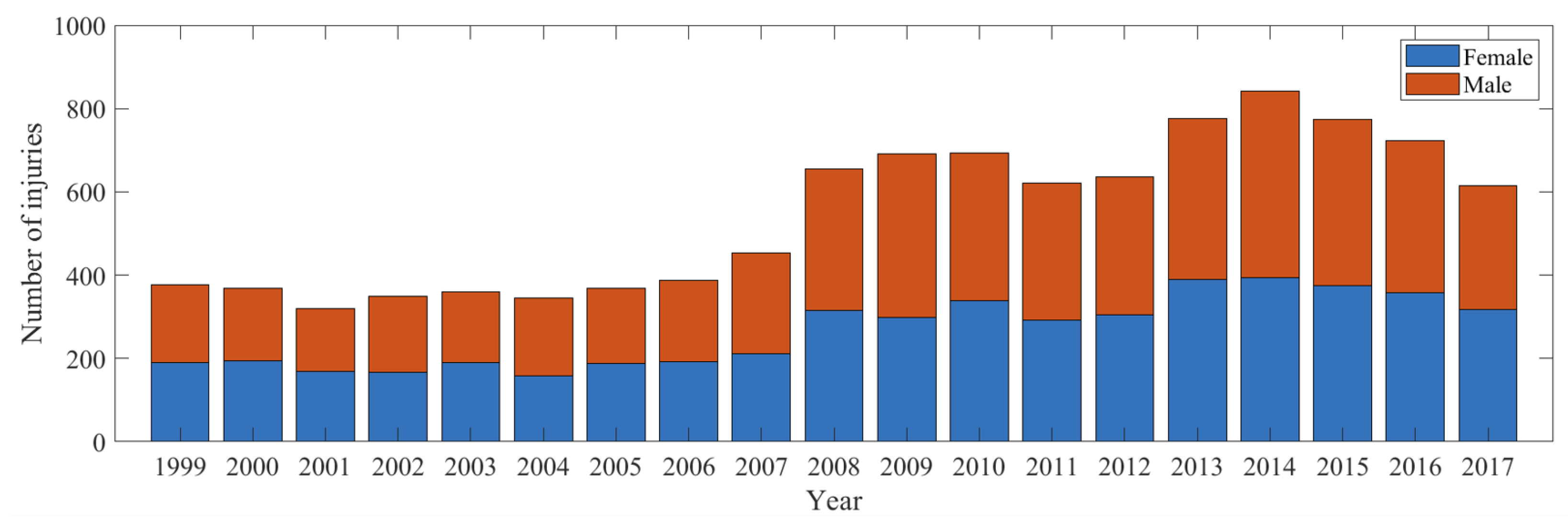
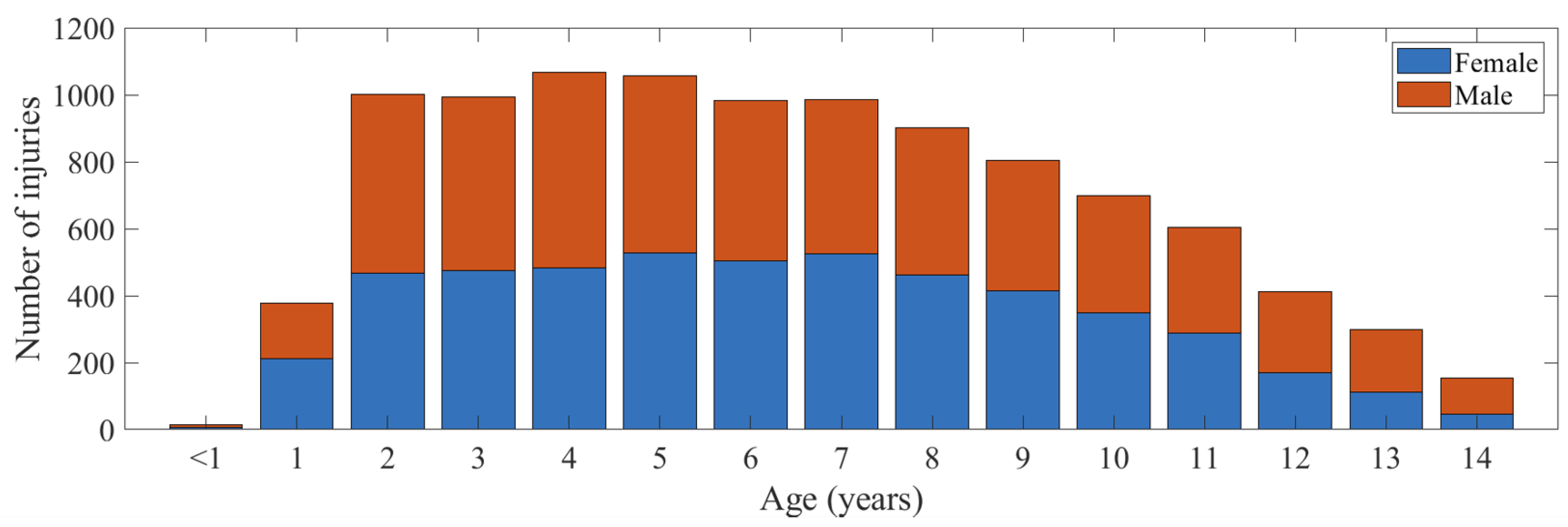
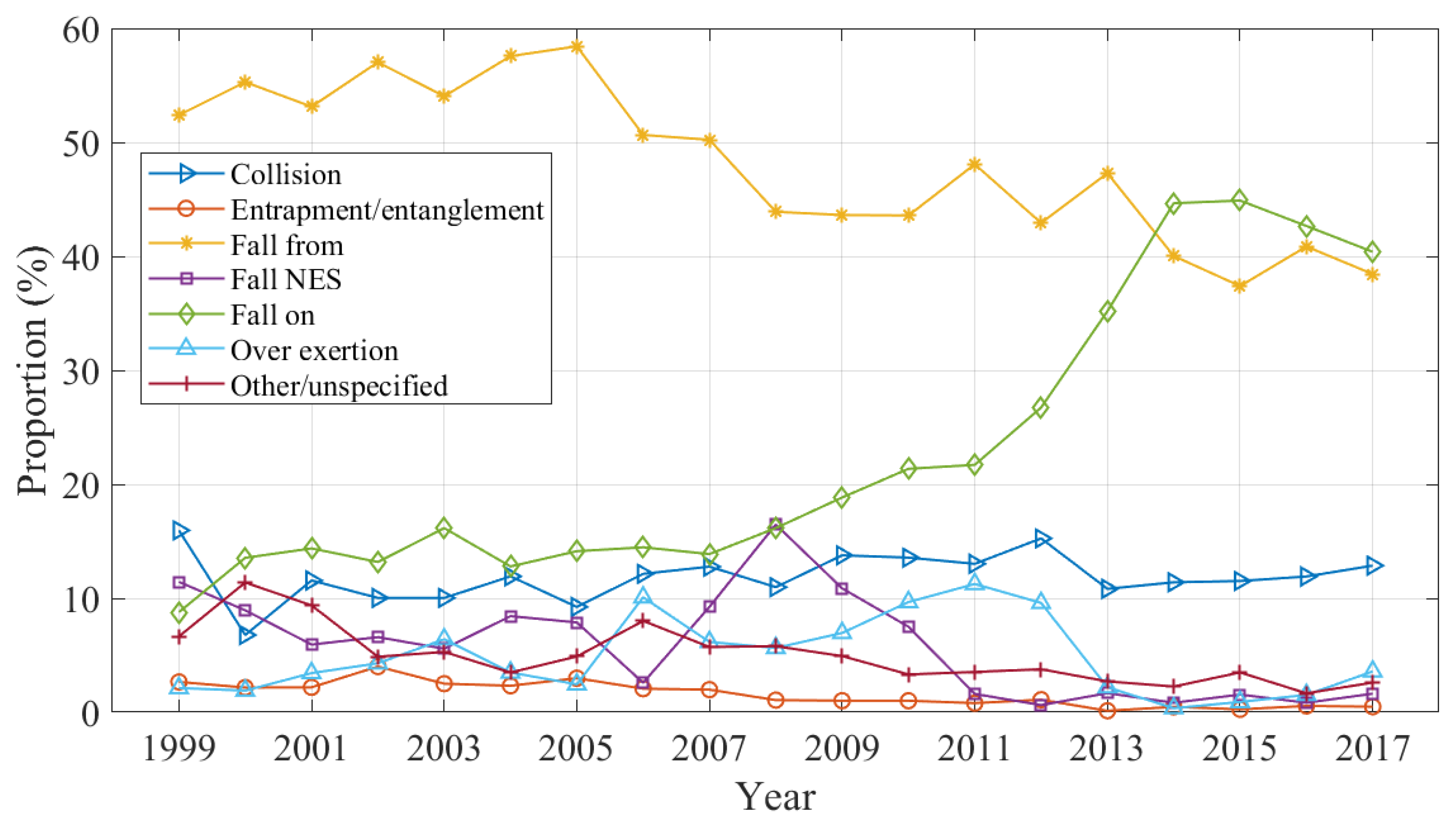
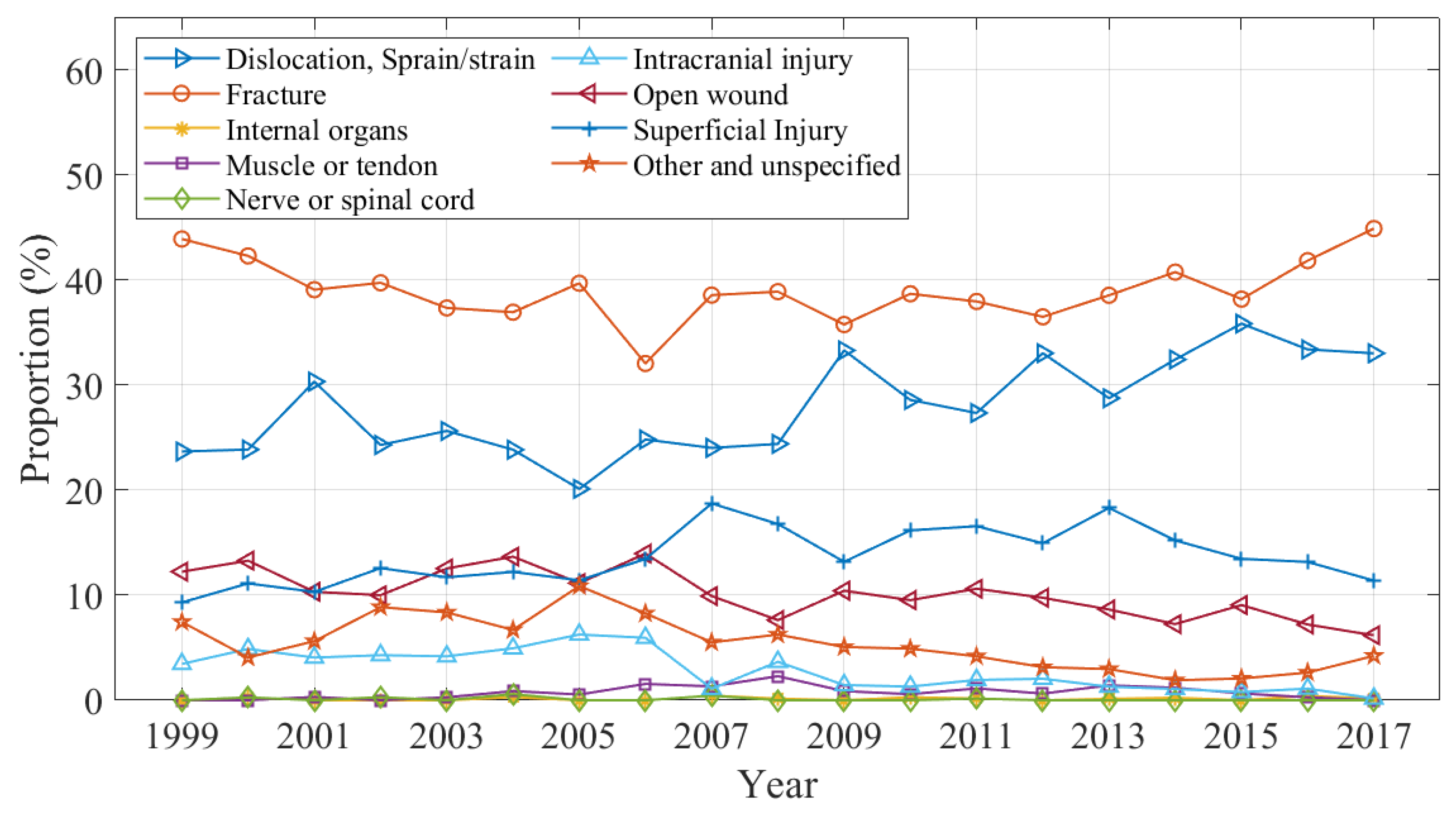
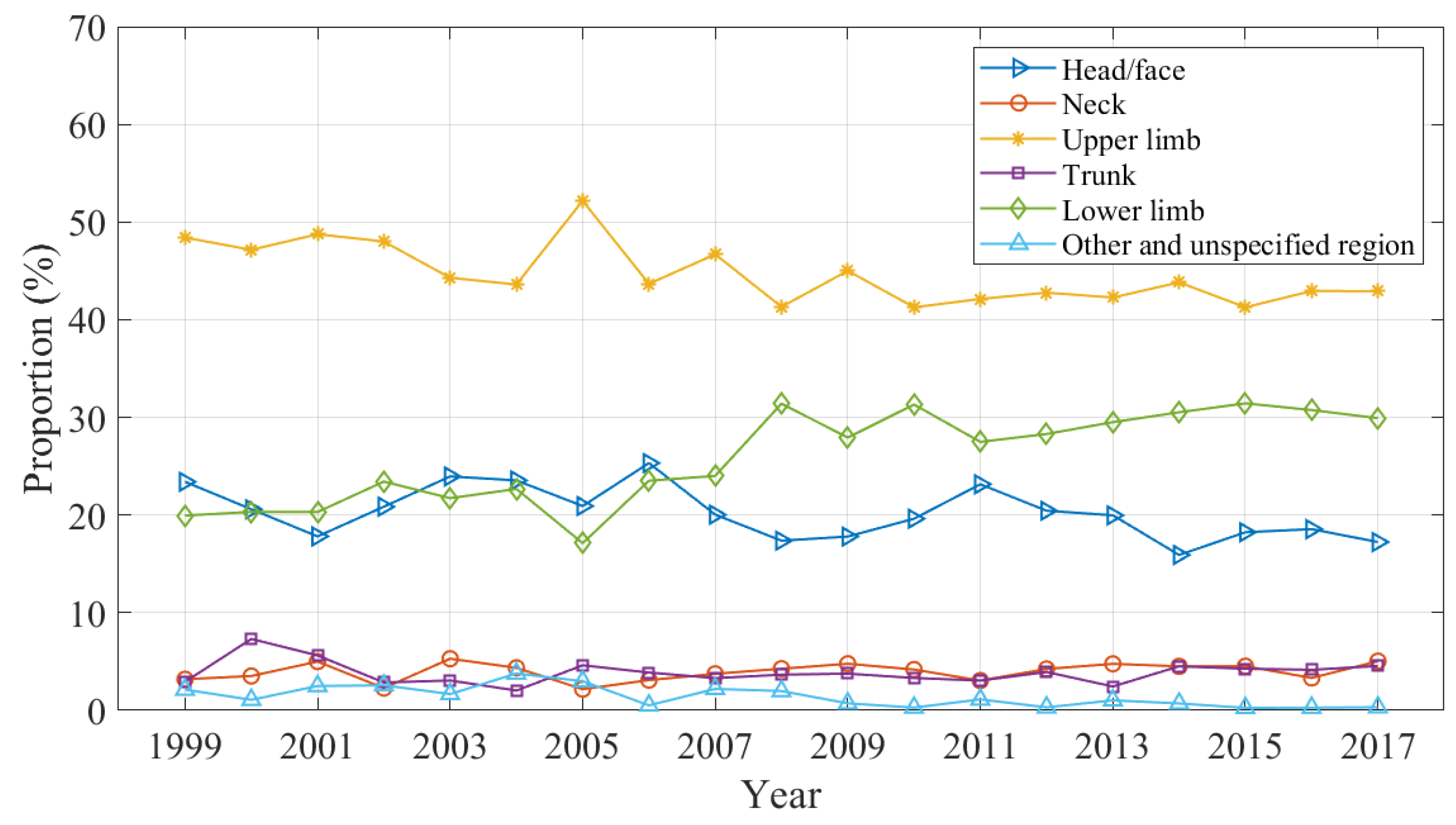
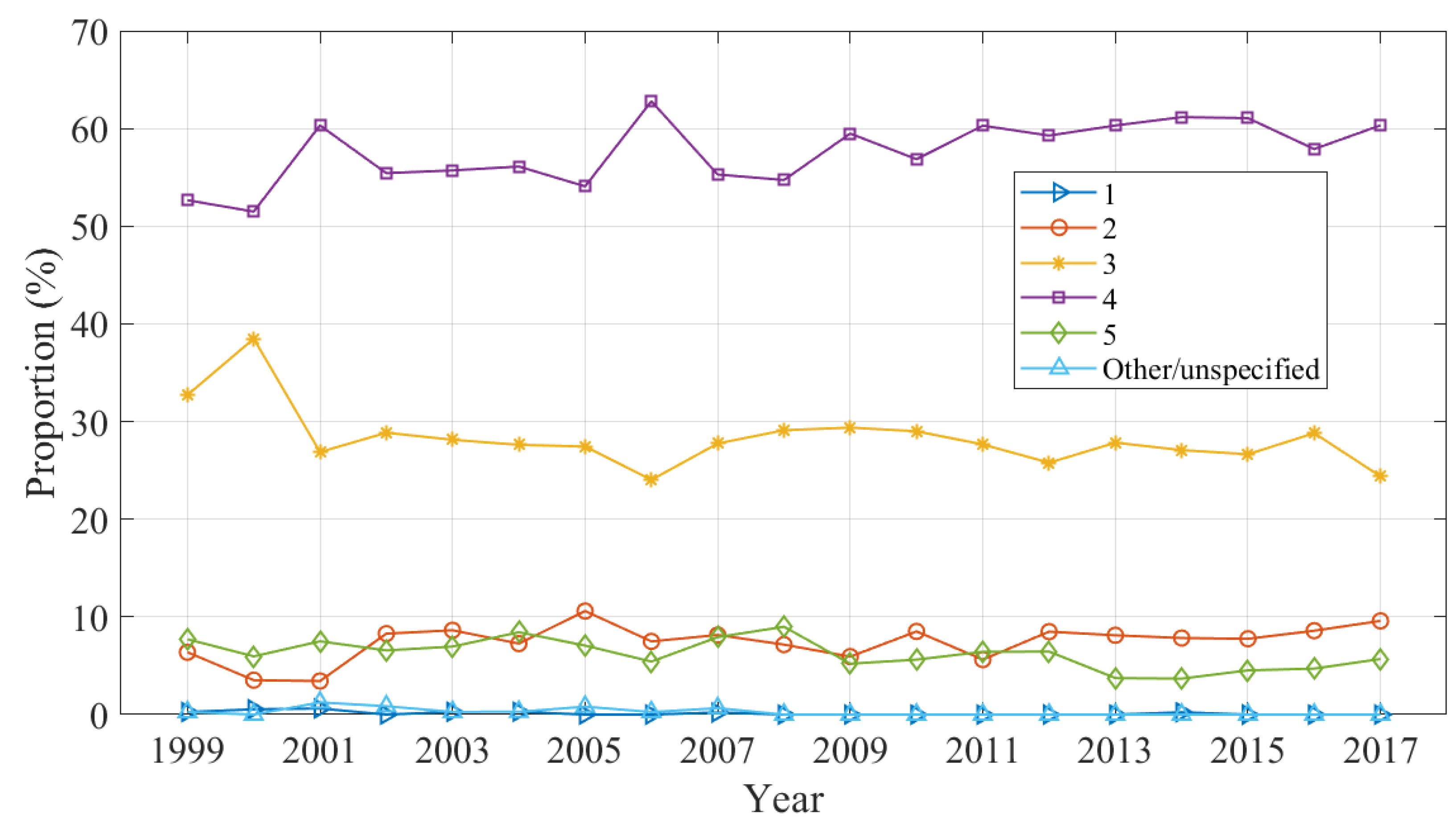

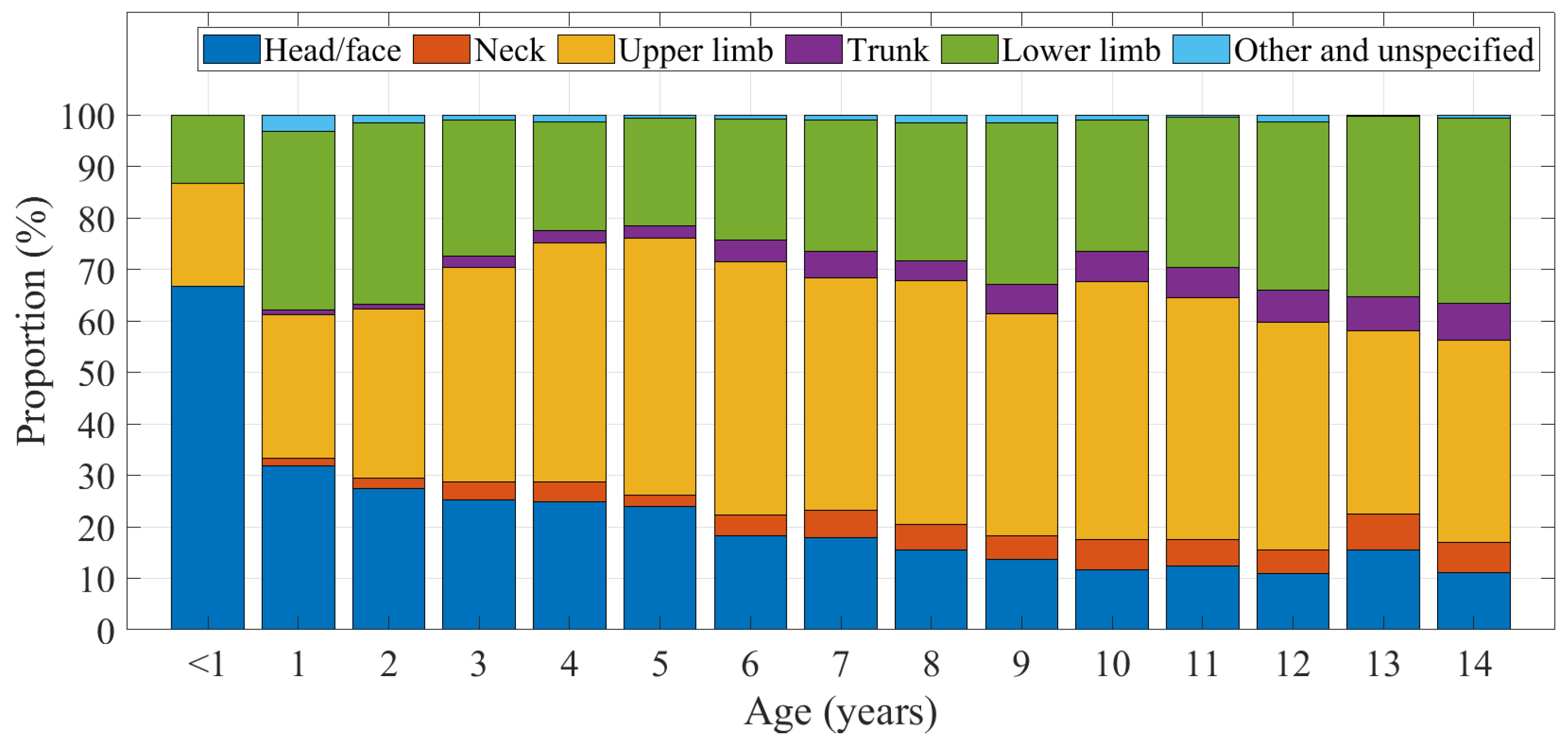
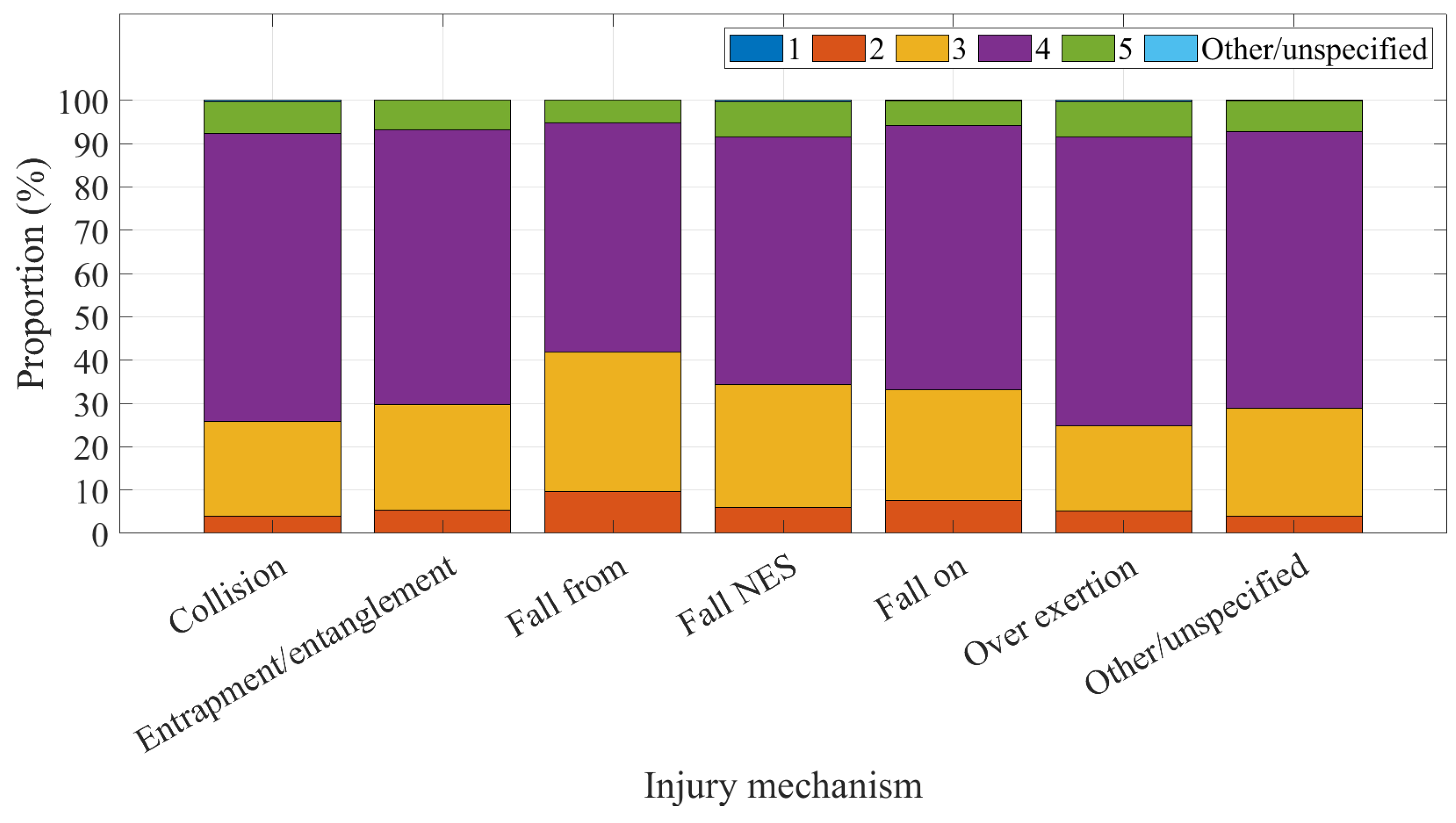
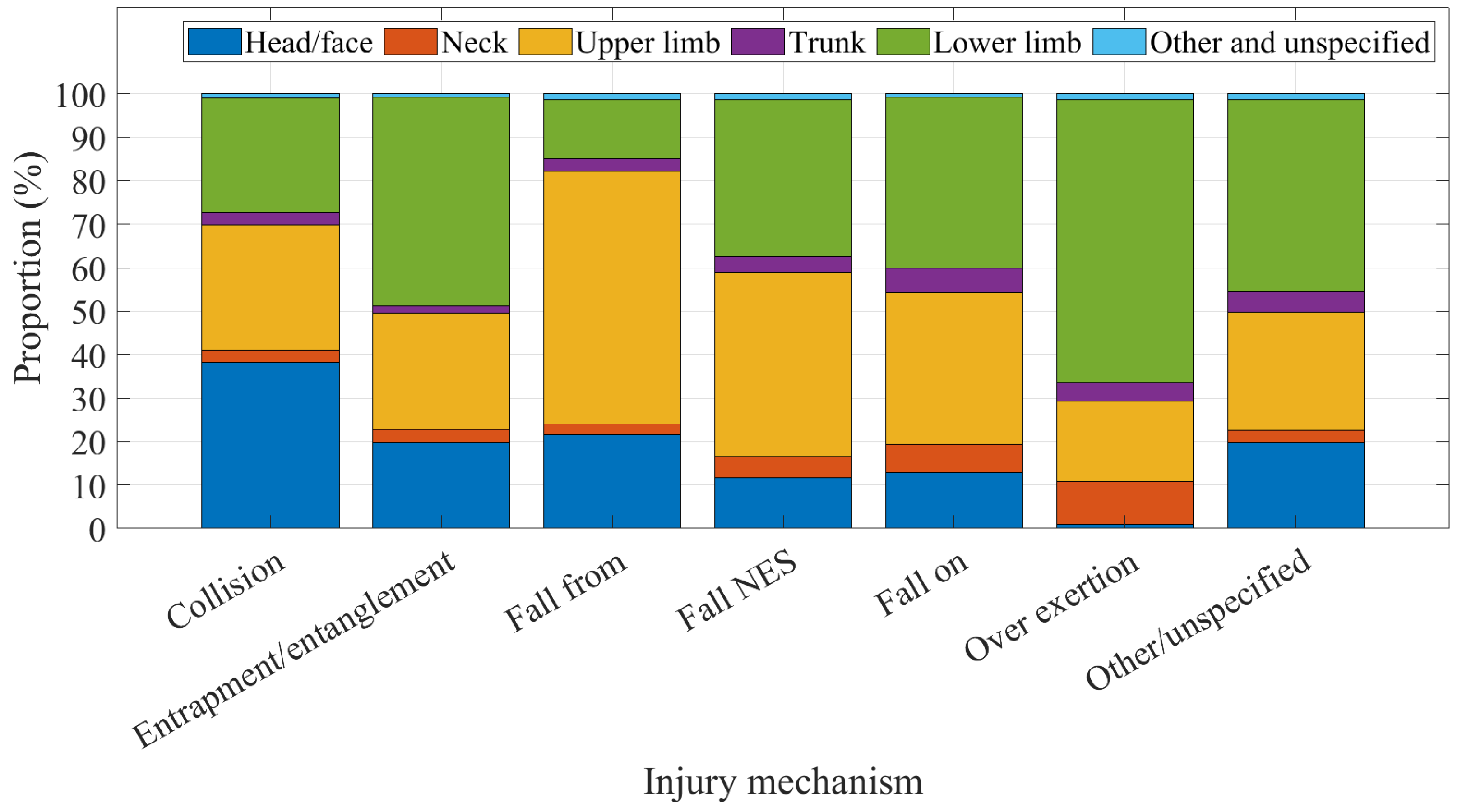
Disclaimer/Publisher’s Note: The statements, opinions and data contained in all publications are solely those of the individual author(s) and contributor(s) and not of MDPI and/or the editor(s). MDPI and/or the editor(s) disclaim responsibility for any injury to people or property resulting from any ideas, methods, instructions or products referred to in the content. |
© 2023 by the authors. Licensee MDPI, Basel, Switzerland. This article is an open access article distributed under the terms and conditions of the Creative Commons Attribution (CC BY) license (https://creativecommons.org/licenses/by/4.0/).
Share and Cite
Eager, D.; Zhou, S.; Barker, R.; Catchpoole, J.; Sharwood, L.N. A Public Health Review into Two Decades of Domestic Trampoline Injuries in Children within Queensland, Australia. Int. J. Environ. Res. Public Health 2023, 20, 1742. https://doi.org/10.3390/ijerph20031742
Eager D, Zhou S, Barker R, Catchpoole J, Sharwood LN. A Public Health Review into Two Decades of Domestic Trampoline Injuries in Children within Queensland, Australia. International Journal of Environmental Research and Public Health. 2023; 20(3):1742. https://doi.org/10.3390/ijerph20031742
Chicago/Turabian StyleEager, David, Shilei Zhou, Ruth Barker, Jesani Catchpoole, and Lisa N. Sharwood. 2023. "A Public Health Review into Two Decades of Domestic Trampoline Injuries in Children within Queensland, Australia" International Journal of Environmental Research and Public Health 20, no. 3: 1742. https://doi.org/10.3390/ijerph20031742
APA StyleEager, D., Zhou, S., Barker, R., Catchpoole, J., & Sharwood, L. N. (2023). A Public Health Review into Two Decades of Domestic Trampoline Injuries in Children within Queensland, Australia. International Journal of Environmental Research and Public Health, 20(3), 1742. https://doi.org/10.3390/ijerph20031742








